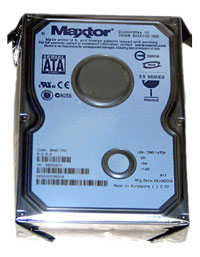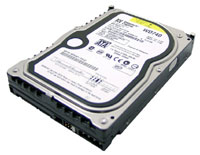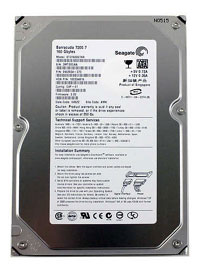Buyer's Guide - Mid-Range, January 2005
by Jarred Walton on January 21, 2005 11:09 AM EST- Posted in
- Guides
Hard Drive Recommendations
We have already said a lot on the topic of hard drives in our past Guides, and there really isn't a whole lot to add at this point in time. Higher capacity models are on the way in the not too distant future, but they will carry with them higher price tags. We recommend SATA drives for most people these days; vendors price them similarly to IDE and it is easier to route the cables. If you're into extreme overclocking, however, IDE may be worth considering. Performance isn't all that different - barring the lack of certain high-end options - and many systems have difficulty reaching top overclocked speeds with SATA drives. For nForce3 250 chipsets, we have found that SATA ports 1 and 2 are more likely to have problems than ports 3 and 4. So, unless you want more than two SATA hard drives, you should be fine.
Hard Drive Recommendation
Seagate 160GB SATA with NCQPrice: $105 Shipped
The best value in terms of price per GB of storage currently goes to the 250 GB Hitachi drive [RTPE: HDS722525VLAT80], at just under 55 cents per GB. 250 GB is a lot of storage, however - probably more than most people really need. With the added benefit of Native Command Queuing (NCQ), the Seagate drives continue to impress. The Seagate 160 GB SATA [RTPE: ST3160023AS] offers the best value of the bunch, at roughly 70 cents per GB, but you also get a longer 5 year warranty. Samsung is a slightly better bargain, so if you don't think NCQ is worth paying extra, you can pick up the 160 GB Samsung for $15 less. We give the recommendation to the Seagate drives, although all of the others that we listed are reasonable alternatives.
 |
 |
| Click images to enlarge. | |
Hard Drive Alternatives
Maxtor 300GB SATA with NCQ and 16MB cachePrice: $194 Shipped
Western Digital Raptor 74GB SATA with TCQ and 10,000 RPM
Price: $177 Shipped
On the other hand, if improved performance is what you're after, the best two choices are either one of the 16MB cache Maxtor drives or the 74GB Western Digital Raptor [RTPE: WD740GD] with its 10,000 RPM design - the Maxtor also offers NCQ while Raptors "only" offer TCQ, in case you were wondering. For storage space as well as performance, we would go with a Maxtor drive, as they are available in 250 and 300 GB models. If you're going to get a drive that large, we would go with the 300 GB model [RTPE: 6B300S0] for the small price increase - 65 cents per MB is pretty good, especially considering the larger cache. If raw speed is your primary concern, the faster rotational speed of the Raptor still wins out, but it is one of the few non-SCSI drives to actually cost more than $1 per GB. Again, we recommend the larger version for its improved performance and features over the original Raptor, but at $177, it costs $2.40 per GB. These drives are great choices, and only you can decide whether raw speed or increased storage is more important, so we recommend them both.
You could even go with a RAID 0 configuration for a possibly small increase in performance, or if you're concerned about data loss, there's the possibility of RAID 1. For a truly high-end setup, you might even think about getting three or more drives and a separate SATA controller with hardware support for RAID 5. That combines the best of both worlds, but it's more than what anyone actually needs. If you're looking into RAID 5 options, make sure that you pick up a controller card with a hardware XOR engine to calculate the parity checks, or else performance will be greatly reduced. RAID of any form is generally a high-end option, however.











46 Comments
View All Comments
JarredWalton - Wednesday, January 26, 2005 - link
^^^ Er, Foxconn is at MonarchComputer.com, not GameVE.JarredWalton - Wednesday, January 26, 2005 - link
44 - This was written by January 18th and published Jan 21st. Things change rapidly, which is why the Buyer's Guides are really just a snapshot in time. There are several NF4 boards now available at Newegg, including the Chaintech and an MSI Neo4 Platinum. Odd that the Chaintech lists "NVIDIA 7.1-channel audio" - is SoundStorm back with NF4? I don't think I had heard about that. The Gigabyte board is also available from quite a few other resellers besides Newegg, of course. There's even a $109 Foxconn NF4 board at GameVE. Interesting! Not that I've had any good Foxconn experiences, but $109 is attractive.jleandro - Wednesday, January 26, 2005 - link
Don't want to be a pain, you guys review whatever boards you think are worthy, but I just checked Newegg and here's what they had IN STOCK:CHAINTECH NVIDIA nForce4 Ultra Chipset Motherboard For AMD Socket 939 CPU, Model "VNF4/Ultra" -RETAIL US$ 135
MSI "K8N Neo4 Platinum" NVIDIA nForce4 Ultra Chipset Motherboard For AMD Socket 939 CPU -RETAIL US$ 159
GIGABYTE "GA-K8NXP-SLI" NVIDIA nForce4 SLI Chipset Motherboard For AMD Socket 939 CPU -RETAIL US$ 249
ASUS "A8N-SLI Deluxe" nForce4 SLI Chipset Motherboard For AMD Socket 939 CPU -RETAIL US$ 265
Interesting that the Gigabyte K8NF-9 was actually not in stock.
hawksballer - Tuesday, January 25, 2005 - link
JarredWalton - Monday, January 24, 2005 - link
41 - Guide editors changed a few months back. The "alternative" configurations have always been more expensive, and they include *all* the alternatives, usually. If you were to take this Guide's alternative (NF4) and stick with the recommend parts everywhere else, price would drop considerably. I haven't made a point of highlighting this, but I did change the pricing targets a bit on the Guides.For the budget, I typically try for $500, but I usually end up closer to $600. Compromises to drop the price are possible but undesirable, i.e. go with 1x256 MB of RAM. The Budget altenative I generally target slightly below the Mid-Range, so $900 to $1000 is usually where it lands.
The Mid-Range has been bumped to $1250 by default, which generally allows for a very good all-around system with few (if any) compromises. The alternative Mid-Range I try to keep under $2000, although closer to $1750 is desirable.
I haven't done any High-End or OC Guides, but High-End will be in the $2000+ range (maxing out at $4000 or so with *all* the trimmings), and the OC Guide is really just about any of the above price goals. I'm working on one of those.
Hopefully that answers your questions. If you want to trim costs a bit on the Mid-Range, going to a slower CPU and GPU usually cuts close to $200, but then it's no longer an all-around system.
-------------
#40: The Chaintech may very well be available in Hungary, but it is not at all available in the US right now. Newegg is the one of the few sites that even list it, and any boards have disappeared *FAST*. If you picked on up without difficulty where you live, more power to you! Lucky #@$^&*%! ;)
wilburpan - Monday, January 24, 2005 - link
Is it just me, or have the Mid-Range and Entry Level Buyer's Guides suffered from price inflation? It seems to me that way back when, the price points for these two were a solid $1000 and $500, respectively. Now the Entry Level Guide has a budget of up to $1000, while the Mid-Range Guide is pushing $2000.I can understand that picking price points is an arbitrary process, but I would think that for comparing what your computer dollar buys you over tme, it would be nice to remain consistent.
jleandro - Monday, January 24, 2005 - link
Can't understand why the Chanitech NF4 Ultra Zenith is not considered to be available.I live in Hungary (not the prime tech spot) and this board has been available for some time, most retailers have it.
In fact I just bought one today for ~110 USD and will pick it up tomorrow.
For instance, check http://www.e-connect.hu under "alaplapok" (motherboard in Hungarian).
JarredWalton - Monday, January 24, 2005 - link
38 - Thanks. It's corrected now. The marketing for the drive states "with SATA-II features" and somewhere along the line that got put in as SATA-II. :| Basically, the drive has hot-swap capability and NCQ, which are both SATA-II. It does not support 300MB/s, but then burst transfer rates really matter much. With sustained transfer rates of even the fastest drives maxing out around 70 MB/s, it will be quite some time before SATA-II transfer rates really show real-world benefit.37 - 0dB computing? I'm not sure I'm the one to address that, but it's certainly something to think about. I'll pass that along and see if we can acquire the parts for such a test. They're relatively expensive in comparison to fan-based solutions, unfortunately.
AnnihilatorX - Monday, January 24, 2005 - link
JarredWalton:A misleading information I just found and thought would like to point out...
The Maxtor Diamond Max 10 300GB with NCQ 16MB cache (6B300S0) is SATA-I/150 in terms of transfer speed, but not SATA-II/300 as stated in page 6.
http://www.anandtech.com/guides/showdoc.aspx?i=232...
"Maxtor 300GB SATA-II with NCQ and 16MB cache"
ceefka - Monday, January 24, 2005 - link
Again a great guide. I was already interested in the Maxtor 300 GB SATA II. I guess in that case you'll have to go with the Gigabyte GA-K8NF-9 or any of the other nForce 4 boards.Would it be a challenge for AT to build a 0dB PC with high end components with Intel and AMD and compare notes. This machine should at least be a mid-range performer or just as high as you can go on 0dB.
I wonder because I'd like to build something really quiet. I have already looked into components like Yesico FL420 and fanless CPU coolers, but I am not sure if all of that will work with also two Maxtor 300GB SATA-II's in http://www.blacknoise.de/shop/de_DE/produkte/id_is...